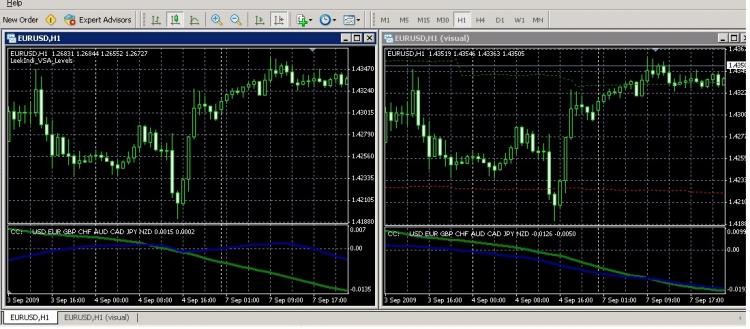CAN ANYONE MAKE CFp MULTI-TIME FRAME AND OBLIGE.
DILIP
Price is the SAME on all time frames so it is time frame independent.
The Complex_pairs1.mq4 indicator is a great indicator!
http://
Dear All !
I like CCFp indicator. Could it code in MT5 ? Please help me !
Many thanks !
Thank you very much for these great indicators, Simeon!
I have just one problem; I made an EA to do some back testing with the CC indicator. But, for some reason, when I make back testing in Visual Mode and compare the CC values in it's window to the values in the "ordinary" chart window, the values are totally different. I.e., if I test EURUSD, there might be a situation where EUR rises over USD in the tester's window. But if I check exactly the same moment in time from an EURUSD window, attached with the CC indicator with exactly the same input values, EUR might be going to a totally different direction than in the tester's window. What's the problem with this?? Have I done something wrong, or is it not possible to use these indicators for history testing at all??
Dear all.
The Complex_pairs1.mq4 indicator looks clever.
How to use the Complex_pairs1 indicator to input/close positions ?
sry for posting in an old thread but i got a question...
i think the calculation in CCFP is wrong, can one check this pls?
double ma(string sym, int per, int Mode, int Price, int i) { double res = 0; int k = 1; int ma_shift = 0; int tf = 0; switch(Period()) { case 1: res += iMA(sym, tf, per*k, ma_shift, Mode, Price, i); k += 5; case 5: res += iMA(sym, tf, per*k, ma_shift, Mode, Price, i); k += 3; case 15: res += iMA(sym, tf, per*k, ma_shift, Mode, Price, i); k += 2; case 30: res += iMA(sym, tf, per*k, ma_shift, Mode, Price, i); k += 2; case 60: res += iMA(sym, tf, per*k, ma_shift, Mode, Price, i); k += 4; case 240: res += iMA(sym, tf, per*k, ma_shift, Mode, Price, i); k += 6; case 1440: res += iMA(sym, tf, per*k, ma_shift, Mode, Price, i); k += 4; case 10080: res += iMA(sym, tf, per*k, ma_shift, Mode, Price, i); k +=4; case 43200: res += iMA(sym, tf, per*k, ma_shift, Mode, Price, i); } return(res); }he forgot the "break;" after each "case" - the result is that he adds values of higher timeframes to the real/correct output value "res" ...

the correct result for H4 is 117,93, because of the missing breaks all higher timeframe results are added with wrong k values...?
why wrong k values?
case 240: res += iMA(sym, tf, per*k, ma_shift, Mode, Price, i); k += 6;
in my picture you'll see k = 7 @ H4 but the IMA call is before we increased k(intial value 1) to 7, the IMA calculation is done with k = 1! this makes no sense, why increase k after we used it? we don't need it anymore?
example code for that H4 line should be like this or did i understand something wrong?
case 240: k += 6; res += iMA(sym, tf, per*k, ma_shift, Mode, Price, i); break;
- Free trading apps
- Over 8,000 signals for copying
- Economic news for exploring financial markets
You agree to website policy and terms of use

New article Theoretical Basis of Building Cluster Indicators for FOREX has been published:
Author: Simeon Semenych